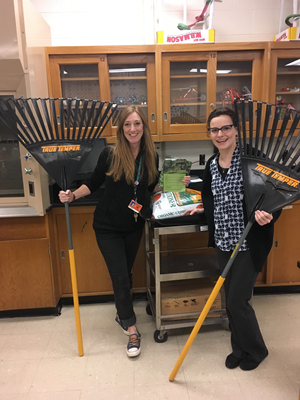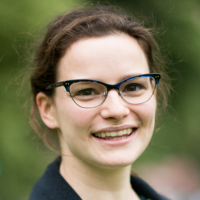As you might have heard, the primary goal of NCSE’s Science Booster Club program is to bring evolution and climate change education to public spaces. But that’s not all! Booster Clubs raise funds and use the proceeds to fund teacher grants. This fall we were able to accept grant requests from any teacher in a state where we have a booster club, making for an especially competitive funding cycle.
One of the microgrants that is near and dear to my heart was awarded to Amy, a high school science teacher in Maryland, who wrote a grant for supplies to support her  environmental club’s native garden. So, I went to the hardware store and purchased the rakes, soil, wheelbarrows, trowels, hand tillers, and 40 pounds of compost and headed to visit Amy's chemistry classroom and the students in the club.
environmental club’s native garden. So, I went to the hardware store and purchased the rakes, soil, wheelbarrows, trowels, hand tillers, and 40 pounds of compost and headed to visit Amy's chemistry classroom and the students in the club.
I arrived at the school just before lunchtime. Amy met me in the front office. She is warm and inviting with her long red hair, ankle length jeans, and Converse sneakers—a real life version of Ms. Frizzle from The Magic Bus.
The scurrying began right away. “I’ve had a lot of different jobs that involved a lot of running around. I’ve worked in retail and as waitstaff at restaurants. Nothing compares to the daily frenzy of teaching,” she said, with a smile from ear to ear. I suddenly felt compelled to walk a little faster. We had 20 minutes to unload and store the gardening supplies, tour the garden, and eat a quick snack before the next class started.
As we headed towards the garden, Amy said, “Listen, it’s not an impressive space right now, but just having supplies and tools is an enormous step.” I saw what she meant. It was a small plot of land with a few plants, a small dedication stone, and not much else. The garden was created in memory of a student who passed away many years ago. While the garden has remained an emotionally important place for the student's parents and community members, over the years it has received varying amounts of attention.
In our subsequent conversations, it became clear that figuring out who was in charge of the garden, who actually maintained it, and how one could create a plan to revitalize it was a daunting task. “Many of my colleagues warned me not to take on this project," said Amy. "They knew the effort needed to get all of the community stakeholders on board would be considerable.”
With some patience and earning the trust of community members, Amy got approval for her environmental club students to transform the current space into a native garden. But there was minimal support from the school and community. However, after receiving the NCSE microgrant, Amy noted how much more excited her school administrators were about the project. Once the seed of funding was planted, her administrators helped Amy to secure more funding for the project. And once she had a little extra buy-in, Amy was able to convince local master gardeners to volunteer their time to help the high schoolers.
“Students will learn about biodiversity, botany, population genetics, and environmental science,” Amy wrote in the grant. When I saw the club students in action, they were going over their first assignment, which was to identify the plants in the garden and determine if they are native or not. The students seemed pretty excited.
With expanded community support and materials from the grant, the garden will be blooming before we know it. I can’t wait to visit in the spring to see what the students and Amy have created. It’s exciting to see how the microgrants we provide through the SBC program can provide seeds that empower teachers to take on big projects. With a little help, we can give people the tools they need to let science education really bloom in their classrooms, school, and communities.

